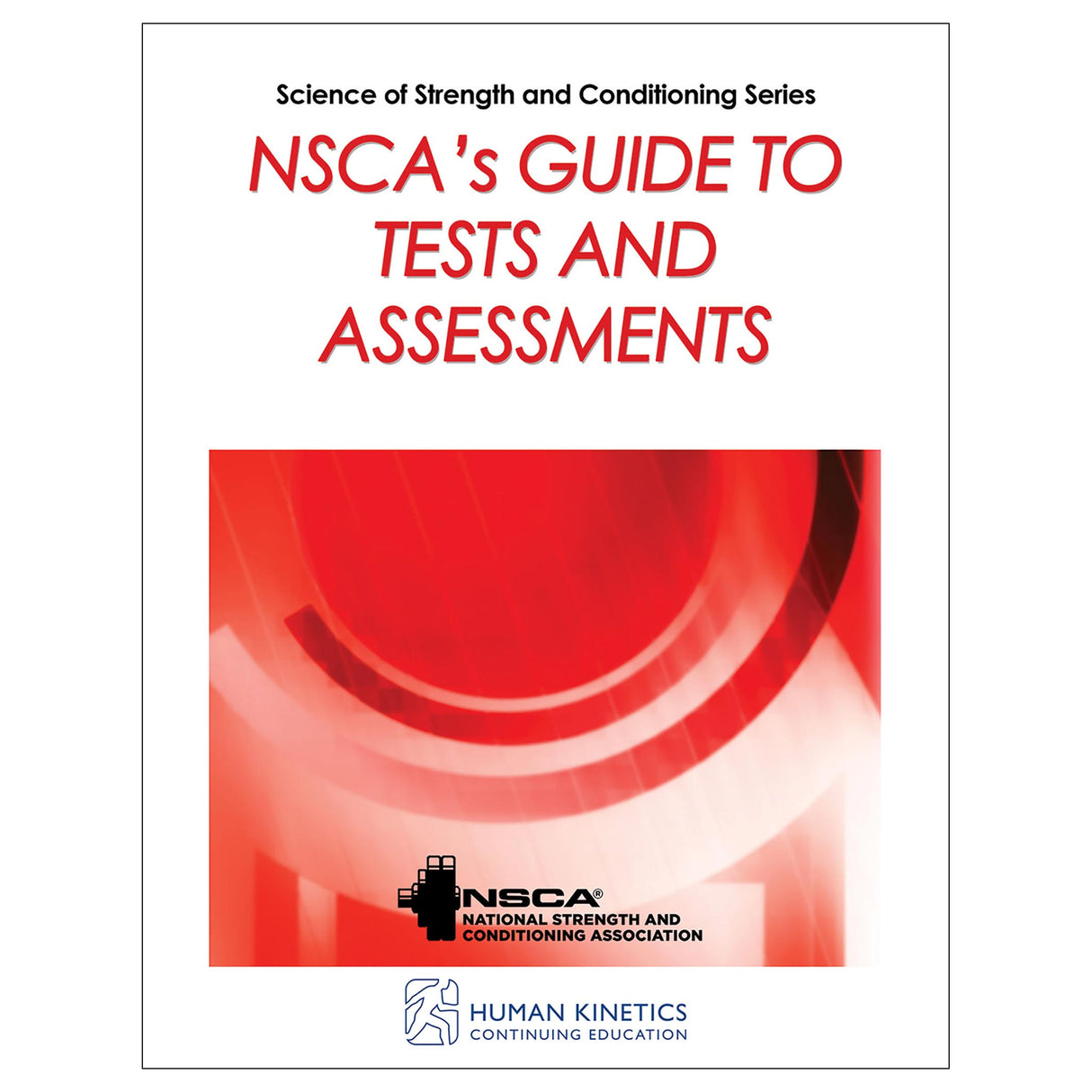NSCA's Guide to Tests and Assessments Online CE Course With Ebook
Author: Human Kinetics
$89.00 USD
Human Kinetics strongly recommends that you complete your exam within the calendar year of your date of purchase to ensure approved credits do not expire for your organization.
- NSCA's Guide to Tests and Assessments ebook
- Online study guide
- Online continuing education exam
Based on the NSCA's Guide to Tests and Assessments ebook, this course provides an introduction to testing, analyzing data, and formulating conclusions. It presents tests and assessments for body composition, heart rate and blood pressure, metabolic rate, aerobic power, lactate threshold, muscular strength, muscular endurance, power, speed and agility, mobility, balance, and stability. You will gain a clear understanding of the test selection process, how to implement appropriate data collection, and how to analyze data to make appropriate training decisions that will help your clients achieve their performance goals.
The study guide includes learning activities, along with an answer key, to help you prepare for the course exam (composed of 100 multiple-choice questions).
Once you complete the course and pass the exam, you can print a certificate for continuing education credits.
Learning Objectives
- Perform a needs analysis and understand how to apply the information.
- Structure testing and assessments around the needs of the population being evaluated.
- Understand various statistical procedures.
- Measure body composition using both direct and indirect methods.
- Identify the metabolic demands of a sport.
- Understand all aspects of the use of a needs analysis.
- Determine heart rate using either indirect or direct methods.
- Understand how blood pressure and heart rate affect training intensity.
- Use heart rate measurements to monitor training progress and dictate programming.
- Determine physical activity energy expenditure using various methods.
- Understand how resting metabolic rate, thermal effect of food, and physical activity contribute to energy expenditure.
- Measure metabolic rate through direct or indirect calorimetry.
- Use monitoring devices to measure training intensity.
- Identify the proper submaximal or maximal testing protocols for assessing aerobic power.
- Correctly administer aerobic power tests and know how to use the collected data to modify training programs when necessary.
- Determine lactate threshold and use it for individualizing training intensity.
- Understand how to determine an athlete’s maximal work rate to predict exercise performance.
- Evaluate aerobic endurance exercise capacity with lactate threshold testing.
- Understand how muscular strength is expressed.
- Measure values of maximal muscular strength directly.
- Predict maximal muscular strength values from multiple repetitions with submaximal loads.
- Safely administer muscular endurance tests to volitional failure.
- Recognize when it is appropriate to use muscular endurance tests that use relative and absolute loads.
- Understand the relationship between force, velocity, and power.
- Identify sports performance needs through assessment of power.
- Select appropriate power tests based on the population and intent.
- Differentiate between tests of speed and agility.
- Identify proper tests to measure and assess mobility.
- Recognize limitations in mobility and how they affect overall function.
- Understand the concepts of center of gravity, center of mass, and base of support.
- Identify and administer appropriate balance and stability tests.
Audience
A continuing education course for certified fitness professionals, including strength and conditioning coaches, personal trainers, and athletic trainers.Matt Rhea, PhD, and Mark Peterson, PhD
Screening Tests
Data Evaluation and Statistical Analysis
Normalizing of Fitness Data
Tracking Data Over Time
Summary
Chapter 2. Body Composition
Nick Ratamess, PhD
Sport Performance and Body Composition
Body Composition Measurement
Measuring Height, Body Weight, and Body Mass Index
Body Fat Standards
Comparison of Body Composition Techniques
Summary
Chapter 3. Heart Rate and Blood Pressure
Dan Drury, DPE
Heart Rate Control
Exercise Intensity and Heart Rate
Sport Performance and Heart Rate
Heart Rate Measurement
Blood Pressure
Summary
Chapter 4. Metabolic Rate
Wayne Miller, PhD, EMT
Components of Energy Expenditure
Sport Performance and Metabolic Rate
Measurement of Energy Expenditure
Prediction of Energy Expenditure
Estimation of 24-hour and Physical Activity Energy Expenditure
Relevance and Applications for Metabolic Testing
Summary
Chapter 5. Aerobic Power
Jonathan Anning, PhD
Regression Equation Variables
Maximal Exercise Testing Methods
Submaximal Exercise Testing Methods
Regression Equation Calculations
Summary
Chapter 6. Lactate Threshold
Dave Morris, PhD
Energy Pathways and Lactate Metabolism
Sport Performance and Lactate Threshold
Performing a Lactate Threshold Test
Maximal Lactate Steady State
Using Lactate Threshold Data
Summary
Chapter 7. Muscular Strength
Gavin Moir, PhD
Definition of Muscular Strength
Factors Affecting Muscular Force Production
Sports Performance and Muscular Strength
Methods of Measurement
Field Tests for Muscular Strength
Predicting 1RM Values from Multiple Repetitions
Laboratory Tests for Maximal Muscular Strength
Isokinetic Strength Testing
Summary
Chapter 8. Muscular Endurance
Gavin Moir, PhD
Definition of Muscular Endurance
Field Tests for Muscular Endurance
Laboratory Tests for Muscular Endurance
Summary
Chapter 9. Power
Mark D. Peterson, PhD
Operationalizing Power
Mechanisms of Power Production and Expression
Types and Factors of Power
Sport Performance and Power
Tests for Power
Lower Body Tests
Upper Body Tests
Warm-Up and Postactivation Potentiation (PAP): A Special Consideration for Testing Power
Summary
Chapter 10. Speed and Agility
N. Travis Triplett, PhD
Speed
Agility
Sport Performance and Speed and Agility
Test Selection
Methods of Measurement
Summary
Chapter 11. Mobility
Sean P. Flanagan, PhD
Fundamental Concepts of Mobility
Sport Performance and Mobility
Mobility Testing
Range of Motion Tests
Interpretation of Results
Comparing Mobility Measurement Methods
Summary
Chapter 12. Balance and Stability
Sean P. Flanagan, PhD
Body Mechanics
Control Theory
Balance and Stability Tests
Sport Performance and Balance and Stability
Measuring Balance and Stability
Interpreting the Results





